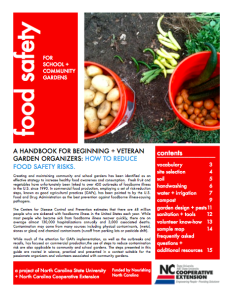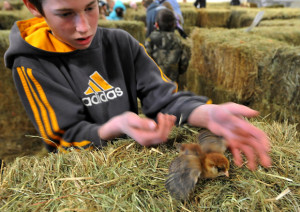My grandparents introduced me to vegetable gardening when I was a kid. I used to leave the city for a couple of weeks each summer and visit them in Campbellford, Ontario (that’s in Canada) and they’d put me to work in their garden. I’d pull weeds, pick up fallen tomatoes (for the compost) and help pick green beans. It’s all a bit hazy, but looking back they didn’t let me handle anything that was ready to eat. Probably because I was dirty.
A few years ago my group was asked by the great folks at the NC Department of Public Instruction about the safety of produce in school gardens. As concerns over healthy food choices grew, more schools were asking about growing their own produce and using gardens as a teaching tool as well as a source of food. The food safety team correctly worried about risks.
I couldn’t find much in the literature on the about pathogens or even production practices at gardens so I figured a good place to start was to get into the field and figure out what was going on. Ashley Chaifetz, barfblog contributor and PhD student at UNC Chapel Hill worked for a summer to figure out the situation and came up with a short document to get garden organizers started (see growingsafergardens.com for all the materials). And then she evaluated it, the results of the project were published yesterday in Food Protection Trends.
Here’s a press release from NC State News Services’ and my main man, Matt Shipman.
School and community gardens have become increasingly popular in recent years, but the people managing and working in these gardens are often unfamiliar with food safety practices that reduce the risk of foodborne illness. Now researchers have developed guidelines that address how to limit risk in these gardens – and a pilot study shows that the guidelines make a difference.
“People involved with these gardens are passionate about healthy eating, food security and helping people connect to where their food comes from,” says Ashley Chaifetz, lead author of a paper describing the work and its effect on school and community gardening practices. “But they often don’t have formal training in how to limit exposure to foodborne pathogens. We developed tools to help educate these gardeners, and our research shows that the tools are effective.” Chaifetz is currently a Ph.D. student at the University of North Carolina at Chapel Hill, but worked in the lab of NC State associate professor and food safety specialist Ben Chapman at the time of the study.
The project, led by Chapman, was borne out of discussions with public school and park officials who asked for food safety guidelines for school and community gardens. The research team then developed a document that lists food safety risks, gives specific instructions on how to limit those risks, and explains how the risk mitigation efforts work.
For example, gardening involves working with your hands, creating the possibility of transferring pathogens to fresh produce. To limit that risk, people should wash their hands before working in the garden – not just after digging in the dirt. So, gardeners should have access to handwashing facilities (and should use them), in order to wash off any pathogens.
The guidelines also offer garden managers advice on how to share the recommendations with volunteers who work in the garden.
Once the guidelines were complete, the researchers wanted to know how and whether the guidance would influence behavior. To find out, they launched a project with 10 community gardens and 10 school gardens.
The researchers conducted on-site, observation-based assessments of food safety practices at all 20 gardens. They then gave the guidelines and related supplies – such as hand soap – to the garden managers.
Two months later, the researchers went back to the gardens to conduct a follow-up assessment.
Sixteen of the 20 gardens improved their overall scores in terms of their use of best practices.
In particular, the researchers found significant improvement in three areas: handwashing; addressing the safety of the site’s water supply; and assessing pre-existing hazards at the site, such as potential soil contamination.
“There’s still room for additional improvement in their food safety practices, but it’s important to note that we saw real advances in risk reduction simply by providing the guidelines,” Chapman says. “We’re exploring additional, follow-up measures, such as webinars and YouTube videos, to see if they lead to additional improvements.”
The guidance, “A Handbook for Beginning and Veteran Garden Organizers: How to Reduce Food Safety Risks,” is freely available online.
The paper, “Implementation of Good Agricultural Practices (GAPs) in School and Community Gardens,” was published online April 30 in the journal Food Protection Trends. Lead author of the paper is Ashley Chaifetz, currently a Ph.D. student at the University of North Carolina at Chapel Hill, but who worked in Chapman’s lab at the time of the study. Co-authors include Elizabeth Driscoll and Chris Gunter of NC State, and Kristina Alnajjar and Alice Ammerman of UNC-Chapel Hill. The work was supported by the North Carolina Department of Instruction, North Carolina Recreation and Parks Association, and the Carolina Center for Public Service at the University of North Carolina.
Here’s the abstract
Implementation of Good Agricultural Practices (GAPs) in School and Community Gardens
Authors: Ashley Chaifetz, Kristina Alnajjar, and Alice Ammerman, University of North Carolina at Chapel Hill; Elizabeth Driscoll, Christopher C. Gunter, and Benjamin Chapman, North Carolina State University
Published: online April 30, Food Protection Trends
Interest in school and community gardens has increased over the past decade as a method to connect students and communities with food production. Although data on gardens as a source for foodborne illness is scarce, growing practices and settings are similar to those in small-scale commercial production. The objectives of this study were to (1) create a set of evidence-based best practices for gardens based on established food safety guidance for fresh produce, (2) create an intervention for delivery, and (3) evaluate the effectiveness of the practices. The guidelines were designed to impact garden organizer and volunteer behavior as well as organizational infrastructure regarding site selection, soil testing, handwashing, water, composting, garden design and fencing, sanitation, and volunteer management. School and community gardens (n = 20, 10 of each) were visited twice, using a pre-post design, and a risk-based observation instrument was administered. Sixteen gardens (80%) improved their overall scores. While the findings demonstrated that handwashing behavior could be altered significantly (P < 0.01) through the provision of the designed intervention, they also suggest a suitable means to take steps toward a safer garden.








